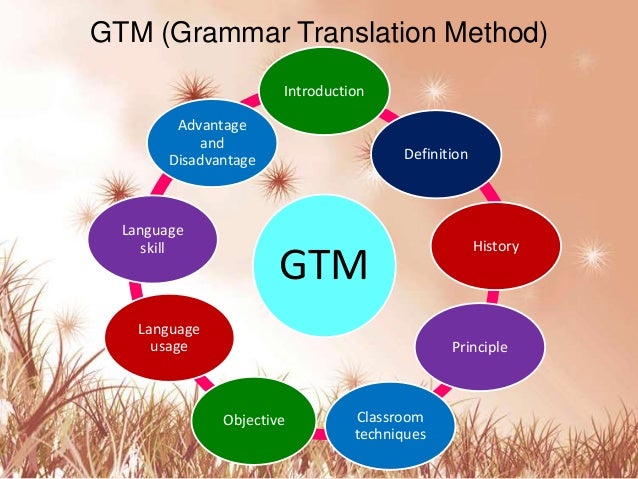Applied Linguistics
UNIT III
UNIT III
To Establish the difference among the METHODS, the APPROACHES, the TECHNIQUES and the TOOLS which are used in the Languages teaching-Learning process as:
1.The Direct Method:
It is sometimes called the natural method, and is often (but not exclusively) used in teaching foreign languages, refrains from using the learners' native language and uses only the target language. It was established in Germany and France around 1900 and contrasts with the grammar–translation method and other traditional approaches, as well as with C.J.Dodson's bilingual method. It was adopted by key international language schools such as Berlitz and Inlingua in the 1970s and many of the language departments of the Foreign Service Institute of the U.S. State Department in 2012.
In general, teaching focuses on the development of oral skills.
Characteristic features of the direct method are:
- teaching concepts and vocabulary through pantomiming, real-life objects and other visual materials
- teaching grammar by using an inductive approach (i.e. having learners find out rules through the presentation of adequate linguistic forms in the target language)
- centrality of spoken language (including a native-like pronunciation)
- focus on question-answer patterns

Direct method is a method of teaching language directly establishing a direct or immediate association between experience and expression, between the English word, phrase or idiom and its meaning through demonstration, dramatization without the use of the mother tongue.
2.The Grammar-Translation method:
The grammar–translation method is a method of teaching foreign languages derived from the classical (sometimes called traditional) method of teaching Greek and Latin. In grammar–translation classes, students learn grammatical rules and then apply those rules by translating sentences between the target language and the native language. Advanced students may be required to translate whole texts word-for-word. The method has two main goals: to enable students to read and translateliterature written in the source language, and to further students' general intellectual development. It originated from the practice of teaching Latin; in the early 1500s, students learned Latin for communication, but after the language died out it was studied purely as an academic discipline. When teachers started teaching other foreign languages in the 19th century, they used the same translation-based approach as had been used for teaching Latin. The method has been rejected by scholars, and has no theoretical basis.

3.Audio-Lingual:
The audio-lingual method, Army Method, or New Key, is a style of teaching used in teaching foreign languages. It is based on behaviorist theory, which postulates that certain traits of living things, and in this case humans, could be trained through a system of reinforcement. The correct use of a trait would receive positive feedback while incorrect use of that trait would receive negative feedback.
This approach to language learning was similar to another, earlier method called the direct method.Like the direct method, the audio-lingual method advised that students should be taught a language directly, without using the students' native language to explain new words or grammar in the target language. However, unlike the direct method, the audio-lingual method did not focus on teaching vocabulary. Rather, the teacher drilled students in the use of grammar.

4.The Structural approach:
The Structural Approach is a technique wherein the learner masters the pattern of sentence. Structures are the different arrangements of words in one accepted style or the other. It includes various modes in which clauses, phrases or word might be used. It is based on the assumptions that language can be best learnt through a scientific selection and grading of the structures or patterns of sentences and vocabulary.
5.Suggestopedia:
Suggestopedia is a teaching method developed by the Bulgarian psychotherapist Georgi Lozanov. It is used mostly to learn foreign languages.
The theory applied positive suggestion in teaching when it was developed in the 1970s. However, as the method improved, it has focused more on "desuggestive learning" and now is often called "desuggestopedia".
Suggestopedia is a portmanteau of the words "suggestion" and "pedagogy". A common misconception is to link "suggestion" to "hypnosis". However, Lozanov intended it in the sense of offering or proposing, emphasising student choice.

6.Total Physical Response (TPR):
Total physical response (TPR) is a language teaching method developed by James Asher, a professor emeritus of psychology at San José State University. It is based on the coordination of language and physical movement. In TPR, instructors give commands to students in the target language, and students respond with whole-body actions.
The method is an example of the comprehension approach to language teaching. The listening and responding (with actions) serves two purposes: It is a means of quickly recognizing meaning in the language being learned, and a means of passively learning the structure of the language itself. Grammar is not taught explicitly, but can be learned from the language input. TPR is a valuable way to learn vocabulary, especially idiomatic terms, e.g., phrasal verbs.
Asher developed TPR as a result of his experiences observing young children learning their first language. He noticed that interactions between parents and children often took the form of speech from the parent followed by a physical response from the child. Asher made three hypotheses based on his observations: first, that language is learned primarily by listening; second, that language learning must engage the right hemisphere of the brain; and third, that learning language should not involve any stress.
Total physical response is often used alongside other methods and techniques. It is popular with beginners and with young learners, although it can be used with students of all levels and all age groups.

7.Communicative Language Teaching (CLT):
Communicative language teaching (CLT), or the communicative approach, is an approach to language teaching that emphasizes interaction as both the means and the ultimate goal of study. Language learners in environments utilizing CLT techniques learn and practice the target language through interaction with one another and the instructor, study of "authentic texts" (those written in the target language for purposes other than language learning), and use of the language in class combined with use of the language outside of class. Learners converse about personal experiences with partners, and instructors teach topics outside of the realm of traditional grammar in order to promote language skills in all types of situations.
This method also claims to encourage learners to incorporate their personal experiences into their language learning environment and focus on the learning experience in addition to the learning of the target language. According to CLT, the goal of language education is the ability to communicate in the target language. This is in contrast to previous views in which grammatical competence was commonly given top priority.
CLT also focuses on the teacher being a facilitator, rather than an instructor. Furthermore, the approach is a non-methodical system that does not use a textbook series to teach English but rather works on developing sound oral/verbal skills prior to reading and writing.

8.The Silent Way:
The Silent Way is a language-teaching method created by Caleb Gattegno that makes extensive use of silence as a teaching method. Gattegno introduced the method in 1963, in his book Teaching Foreign Languages in Schools: The Silent Way. Gattegno was critical of mainstream language education at the time, and he based the method on his general theories of education rather than on existing language pedagogy. It is usually regarded as an "alternative" language-teaching method; Cook groups it under "other styles", Richards groups it under "alternative approaches and methods" and Jin & Cortazzi group it under "Humanistic or Alternative Approaches".
The method emphasizes learner autonomy and active student participation. Silence is used as a tool to achieve this goal; the teacher uses a mixture of silence and gestures to focus students' attention, to elicit responses from them, and to encourage them to correct their own errors.
Pronunciation is seen as fundamental to the method, with a great deal of time spent on it each lesson. The Silent Way uses a structural syllabus and concentrates on teaching a small number of functional and versatile words. Translation and rote repetition are avoided, and the language is usually practiced in meaningful contexts. Evaluation is carried out by observation, and the teacher may never set a formal test.
9.Communicative Language Learning:
It is a language-teaching method in which students work together to develop what aspects of a language they would like to learn. It is based on the Counselling-approach in which the teacher acts as a counsellor and a paraphraser, while the learner is seen as a client and collaborator.
The CLL emphasizes the sense of community in the learning group, it encourages interaction as a vehicle of learning, and it considers as a priority the students' feelings and the recognition of struggles in language acquisition. There is no syllabus or textbook to follow and it is the students themselves who determine the content of the lesson by means of meaningful conversations in which they discuss real messages. Notably, it incorporates translation, transcription, and recording techniques.

10.Immersion:
It is a technique used in bilingual language education in which two languages are used for instruction in a variety of topics, including math, science, or social studies.The languages used for instruction are referred to as the L1 and the L2 for each student, with L1 being the native language of the student and L2 being the second language to be acquired through immersion programs and techniques. There are different contexts for language immersion, such as age of students, class time spent in the L2, subjects taught, and the level of participation by the native L1 speakers.
Although programs differ by country and context, most language immersion programs have the overall goal of promoting bilingualism between the two different sets of language speakers. In many cases, biculturalism is also a goal for speakers of the majority language (i.e. the language spoken by the majority of the surrounding population) and the minority language (i.e. the language that is not the majority language). Research has shown that these forms of bilingual education provide students with overall greater language comprehension and production of the L2 in a native-like manner; in addition to, greater exposure to other cultures and the preservation of languages, particularly heritage languages.
11.Task-Based Language Learning:
Also known as task-based instruction (TBI), focuses on the use of authentic language and on asking students to do meaningful tasks using the target language. Such tasks can include visiting a doctor, conducting an interview, or calling customer service for help. Assessment is primarily based on task outcome (in other words the appropriate completion of real world tasks) rather than on accuracy of prescribed language forms. This makes TBLT especially popular for developing target language fluency and student confidence. As such TBLT can be considered a branch of communicative language teaching (CLT).
12.The Lexical Syllabus:
It is a method of teaching foreign languages described by Michael Lewis in the early 1990s. The basic concept on which this approach rests is the idea that an important part of learning a language consists of being able to understand and produce lexical phrases as chunks. Students are thought to be able to perceive patterns of language (grammar) as well as have meaningful set uses of words at their disposal when they are taught in this way.
In the lexical approach, instruction focuses on fixed expressions that occur frequently in dialogues, which Lewis claims make up a larger part of discourse than unique phrases and sentences. Vocabulary is prized over grammar per se in this approach. The teaching of chunks and set phrases has become common in English as a foreign or second language, though this is not necessarily primarily due to the Lexical Approach.
The lexical syllabus is a form of the propositional paradigm that takes 'word' as the unit of analysis and content for syllabus design.

No hay comentarios:
Publicar un comentario